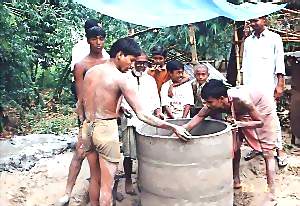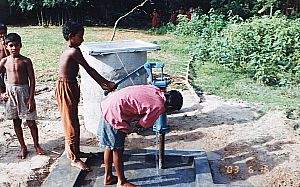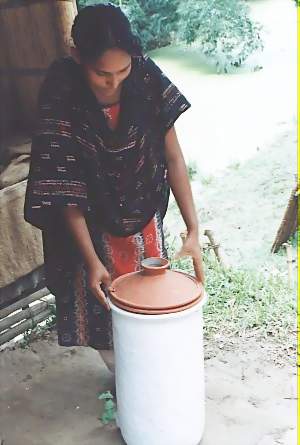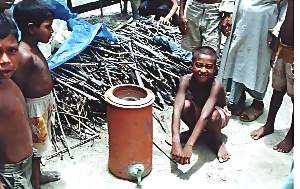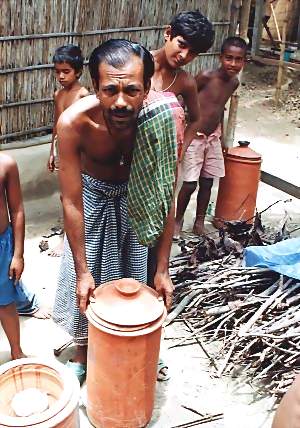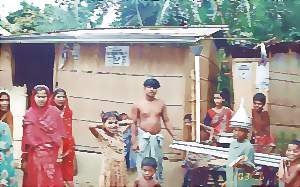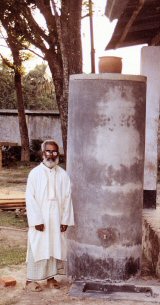Back to Content
2. AIM OF THE PROJECT
After reviewing present situation on the basis of people's educational background, acceptability and tradition the following aims of the project were in background:
Our goal is to transfer knowledge on water, air, and soil - special emphasis on water. How to combat present disastrous situation through arsenic poisoning.
Priority of the project is to give people an immediate cheap solution. Our studies show that "Open Dug Holes", rain water harvesting with filters and to drill "arsenic free water trap" within contaminated aquifers are the simplest solution. Also we aim to obtain waterborne disease free water at affordable means.
In Bangladesh most of the rural population is still uneducated and most of the arsenic mitigation projects have been failed. Teachers and students are targeted for environmental education and can make greater impact on their parents. To publish an educational book on water, which is badly needed in developing countries.
Our goal is to transfer knowledge on water, air, and soil - special emphasis on water. How to combat present disastrous situation through arsenic poisoning.
Remove social isolation of arsenic affected patients
Priority of the project is to give people an immediate cheap solution. Our studies show that "Open Dug Holes", rain water harvesting with filters and to drill "arsenic free water trap" within contaminated aquifers are the simplest solution. Also we aim to obtain waterborne disease free water at affordable means..
Simple mix media sand filter can reduce arsenic concentration and remove biological contamination
To find out alternative arsenic free water. Experience has shown that tube wells near water pond contains less arsenic, at particular depth water is arsenic free, aquifer on channel sand in particular area arsenic free etc.
Back to Content
3. PROJECT REPORT
The following items are the milestones of the project that have been achieved:
1. Selection of location after drilling and construction of Dug Wells.
2. Dug well filter and pump.
3. Distribution of Water Filter with local materials.
4. Identification of facies change within contaminated area and locate and construct arsenic free wells.
5. Rain water harvesting.
Dug Wells
Ground water moves through rocks and subsurface soil, it has a lot of opportunity to dissolve substances as it moves. For that reason, ground water will often have more dissolved substances than surface water will.
Even though the ground is an excellent mechanism for filtering out particulate matter, such as leaves, soil, and bugs, dissolved chemicals and gases can still occur in large enough concentrations in ground water to cause problems. Underground water can get contaminated from industrial, domestic, and agricultural chemicals from the surface.
Advantages of dug wells are:
Dug wells are indigenous technology in Bangladesh.
The wells are cheaper and easier to construct and less susceptible to bacteriological contamination (BRAC, August 2000).
Natural biological filtration occur, when water percolates through sand bodies (develop microbial flora whose metabolism contributes to the effectiveness of removing effluents)
In dug wells within the standing water simple sedimentation take place and has been found frequently a substantial reduction in BOD (Biological Oxygen Demand).
Natural iron coagulation and settlement occur within standing water (decrease in arsenic, suspended solids, ammonia, nitrate and phosphate content
An Easy Alternative to Obtain Arsenic Free Water Our studies show that dug wells do not contain arsenic (very low), where as neighbouring tube wells contain extremely high amount of arsenic in water. "Dug well" is an indigenous technology and social acceptance is very high and can be constructed with local available source.
In arsenic affected villages when water from many hand tube wells are arsenic contaminated and many have arsenical skin lesions but those (small in number) drinking water from dug wells have no arsenical skin lesions and much healthier compared to those suffering from arsenic toxicity.
Construction of such wells with cement ring walls provide bacteria free water, if the place is sunny and without trees. Simple sand filter produced and maintained by the villagers
Soil is, in fact, more resilient in handling the constantly changing blends of toxic materials. The diverse community of organism present in soil are better able to react to changes in the chemistry of the wastewater to be treated. Soil filters are more effective when plants are grown on them.
Soil Acts as Active Coal:
Micro flora and fauna removes pollutants
.
Clays also adsorb arsenic because of the oxide-like character of their edges, as do carbonates. Of these components, adsorption by iron oxides is probably most important in sandy aquifers because of their greater abundance and the strong binding affinity. Nevertheless, if studies of soil phosphate are a guide, then aluminium oxides can also be expected to play a significant role when present in quantity. Experience from water treatment (Edwards, 1994) suggests that below pH 7.5 aluminium hydroxides are about as effective as iron hydroxides (on a molar basis) for adsorbing As (V) but that iron salts are more efficient at higher pH and for adsorbing As (III). Arsenic (V), like phosphate.
Surface water percolates through (4-6 meters) soil, silty sand and accumulates in fine to medium sand (aquifer) of dug wells. If dug wells are constructed with proper care, natural biological system removes nitrogen, germs, bacteria and viruses.
Our ancestor knew this wisdom. Even now people say, "Drink crystal clear water. Don't drink water with micro-organisms!"
Back to Content
3.1. List of dug wells constructed
Selection of location after drilling geological formation and construction of Dug Wells:
The following areas have been selected after several drilling and formation evaluation:
- Kasnail Yusuf Hossain Primary School,
Kasnail.
- Bhatpara Yusuf Hossain Primary School,
- Ansaruddin High School, Ambikapur.
- Hanif Shekh, Ramkhando, Kanapur
- Village Betbaria, Tambulkhana
- Akand Vhatpara, Kalitola, Tambulkhana
- Tambulkhana Bazar, Tambulkhana
- Village Khalkandi, Kanaipur
- Harishava (near Shkati's House), Dhakin tepakhola
- Narayan Sheel, Dhakin Tepakhola.
- Police Line, Faridpur.
- Kader Mollah, Tambulkhana, Faridpur.
- Sadipur Primary School, sadipur, Faridpur.
- Jashim Uddin, Ambikapur, Faridpur.
- Village Kuzurdia, Tambul Khana, Faridpur.
- Khalilpur Bazar, Khalilpur, Faridpur
- Pachim Khalashpur, Faridpur.
- Bashu Dev, Pachim Alipur, Faridpur.
- Ramkhanda Primary School, Kanaipur Union, Faridpur.
- Kaznail Primary School, Kaznail, Kauzuri Union, Tambulkhana, Faridpur.
- Shibrampur Basti (Slum), accross Ambikapur Railway Staion.
|
Construction of dug wells is based on traditional wisdom of the rural people of Faridpur. It is believed that success would and will be derived through linking the traditional understanding of the indigenous peoples' culture with modern technique to mitigate their ailments. All dug wells are constructed where water situation is very disastrous and poor rural people who cannot afford Tk. 2000-3000. (50 US Dollars). Government and NGOs collect this money, before they mitigate. Only the rich can afford it.
One dug hole at Kader Mollah, Tambulkhana could not be completed as severe poisonous gas exposed during digging. If gas disappears, the well will be taken under consideration the next dry season.
All these schools are situated in most neglected arsenic affected areas of Bangladesh. About 2300 students are attending these schools. Villagers surrounding schools are also benefited to obtain arsenic free water. We obtained very cordial cooperation from teachers, students and villagers.
In dug holes to obtain active and good quality of water the traditional bucket system is the best as oxygenation occurs and insects cannot grow.
Back to Content
3. 1. 1. CLOTH FILTER CUTS CHOLERA DEATHS
We have advised and used cloth filter to all villagers.
Simply filtering drinking water though cloth from old clothes can cut new cholera cases in half, researchers have found. The technique was tested in Bangladesh, where it could potentially save many lives. Cholera is a waterborne disease that causes severe diarrhoea. It kills tens of thousands of people a year world-wide.
Scientists have long known that the bacteria that cause cholera live in a mutually beneficial symbiotic relationship with tiny aquatic organisms called plankton. Researchers from the US National Science Foundation decided to test the theory that filtering plankton out of drinking water would also remove the cholera bacteria. They found that an old sari cloth, folded at least four times, was as successful as specially designed nylon filters at removing plankton from water.
The method can save thousands of lives during massive epidemics, particularly those of children under the age of five." Dr Claire-Lise Chaignat, coordinator of the World Health Organization's global taskforce on cholera control, said the technique sounded "very promising". She said: "Cholera affects only the poorest of the poor who have hardly any access to safe water or proper sanitation. "A simple method of cleansing water for these people would be very interesting."
We found a big acceptance among the villagers but more mass campaign is needed
.
Back to Content
3. 2. HOUSEHOLD FILTER Jibon (Life)
The NGOs and companies distribute the filter but due to clogging, no device for back-washing and colouring of water, growth of pathogen within the filter and expensive to replace etc. people refuses to use them: Available arsenic removal technologies are neither cost effective for the poor nor easily operable and maintainable. For example devices based on sorptive techniques need periodic regeneration by washing as flocculate particles clog the filter media slowing down flow rate which makes those devices cumbersome to use After some days there may arise filter media which demands extra replacement cost.
The risk of harmful bacteria can grow and increase substantially within the filter, if it is not properly maintained. Another process is coagulation-flocculation-co-precipitation with chemicals that may leave harmful residual elements in dissolved state in water. If coagulated with alum and potassium permanganate, there is a chance of having residual aluminium, potassium etc. in treated water that may have toxic effects on human nervous system. DPHE and DANIDA have introduced this system. In Faridpur they have distributed two-bucket system, but no body uses it.
There are several expensive filters are available in the market, but nobody knows their effectiveness.
None of the project has arsenic disposal programme.
Agencies have failed to give the people arsenic free water, environmental conscious education.
No water-purification device is capable, by itself, of removing all of the toxics from drinking water. Many unscrupulous companies and salespeople sell water-purification equipment to cash in on people's fears about polluted water to make a quick money.
The versatility of the sand filter is reflected in the numerous design variations that have been developed to address many different climatic and development conditions. Nearly a dozen variants of the basic sand filter design are currently in use, and engineers and practitioners continue to create more. A simple sand filter in a clay pot for 20-litre water has been introduced to remove arsenic and other contaminants. Sand filters are not simply physical filters, as in the percolating filter the sand particles develop a microbial flora whose metabolism contributes to the effectiveness of the process
We have innovated clay potters of Mallikpur to produce simple filter (like popular "Surma Filter") with candle (sand, clay) that stops colio bacteria and reduces arsenic concentration
.
Distribution of Clay Pot and Filter
Malikpur clay potter's filter has been distributed to arsenic affected villagers:
| Union/Villages |
Number of Filters |
| Kazuri Union |
60 |
| Ambikapur/Faridpur Sadar |
20 |
| Kanaipur |
20 |
Regular maintenance is an essential component of the operation of a sand filter. At least once a year each filter should be verified as most filters exhibit diminished capacity after a few years due to surface clogging by organic matter, fine silts, hydrocarbons, and algal matter. Operation of sand filter requires replacement of the surface sand layer on a relatively frequent basis.
Back to Content
3. 3.RAIN WATER HARVESTING
Bangladesh is one of the richest countries in the world in rain and surface water per capita and yet it is one of the most unutilized of all resources. With ground water unreliable and over exploited, surface water preservation has become an urgent environmental need. And the failure to provide people with safe drinking water by the State becomes a violation of the basic right to life.
Corrugated iron roofs are ideally suited for rain water harvesting, though terra cotta or wood tiles, or concrete roofs are also acceptable. Thatched roofs are not appropriate for rainwater collection, as the collected water is high in organic matter. These roofs, however, can be made suitable with the simple use of inexpensive plastic sheeting. Roofs should be cleaned thoroughly at the beginning of every rainy season, regular maintenance is also crucial.
Water is collected from the roof surface in gutters, which are connected to a storage tank with a downpipe. In order to minimize the amount of contamination and organic matter in collected water, a fine mesh netting or coarse sand filter should be placed between the downpipe and the storage tank. This will also help to keep insects and small animals out of the tank, and has been shown to improve water quality, and reduce the risk of mosquito breeding.
When rain falls, after a dry period, water should not be collected for the first ten to fifteen minutes, in order to clean the collection surface. This 'first flush' can be achieved through use of a bypass valve, or through a variety of simple designs.
Water Quality
The bacteriological quality of rainwater will depend on the collection and storage methods. In a well-designed system, pathogenic bacteria counts are low in collected rainwater, and the conditions (lack of light or food source) do not promote their growth. Under these conditions pathogen levels will actually decrease with storage, rather than increase. Typically, some coliform bacteria can be found in collected rainwater, but usually the bacteria are not fecal in origin (Pacey and Cullis, 1986).
Several reviews of bacteriological quality of rainwater have been made: in some cases, fecal and total coliform counts are extremely low (Dillaha and Zolan, 1985), but more commonly low levels of coliform bacteria are found. Typical fecal and total coliform counts in water collected from rooftops average 5-15 and 25-75 per 100 ml, respectively (e.g. Pinfold et al., 1993; Appan, 1997; Simmons et al., 1999a).
By examining the ratio of fecal coliforms to fecal streptococci, Appan showed that approximately 80% of the fecal contamination was of non-human origin, presumably from animal droppings on the rooftop (Appan, 1997). Simmons and others found similar coliform counts in rural New Zealand, though occasionally counts were significantly higher (maximum total and fecal coliforms were 19,000 and 840 per 100 ml). Two samples showed Cryptosporidium, but none showed Giardia, Campylobacter, or Legionella pneumophila (Simmons et al., 1999a).
Yaziz and others found moderate levels of coliform bacteria in rainwater collected from rooftops, and showed that the highest counts were in the first samples collected during a rainfall. When samples were collected after a 'first flush' equivalent to 35 liters per 100 square meters of roof catchment area, no fecal coliforms could be detected, and total coliforms were reduced by over 50% (Yaziz et al., 1989).
We have found keen interest on rainwater collection in the arsenic affected areas. We have selected all local materials and local carpenters and potters made rainwater collecting 12 units at worst affected poor rural areas. Water filter is also under construction. It is possible to collect a huge amount of rainwater. Rainwater collection makes the life of the women comfortable as they do not require carrying water from a long distance.. Advertisement in the newspaper to use rain- water does not have any affect on villagers. If simple method is shown practically, the villagers can easily repeat it.
Rain water collection is very popular
Women collects water from far distance and water at house door is a great relief for the women.
Food tastes better like rice, lentil.
This is possible to store rain water for the whole year. The tank may be costly but cheaper than any other arsenic removal plants.
Small rain water tank for Ansaruddin high School School students(650 students) has been successful. This has been constructed with coarse sand and brick chips with mix media sand filter at the top. It sweats and wind keeps the water cool.
Importance of Rain Water Harvesting:
To arrest ground water decline and improve ground water levels and availability.
To beneficiate water quality in aquifers.
To arrest sea water ingress.
To conserve surface water run-off during monsoons.
To enhance availability of ground water at the specific place and time.
To reduce power consumption.
To conserve urban waste water.
List of Rainwater Harvesting Units:
| Name |
Village |
| Ansaruddin High School |
Ambikapur |
| Zahid Mollah |
Kuzurdia, Kozuri Union |
| Zahid Mollah |
Kuzurdia, Kozuri Union |
| Idris Mollah |
Kuzurdia, Kozuri Union |
| Jabbar Mollah |
Kuzurdia, Kozuri Union |
| Mohinuddin Mollah |
Kuzurdia, Kozuri Union |
| Jabbar Mollah |
Kuzurdia, Kozuri Union |
| Humayun Mollah |
Kuzurdia, Kozuri Union |
| Md. Qasem Mollah |
Kuzurdia, Kozuri Union |
| Sobhan Mollah |
Kuzurdia, Kozuri Union |
| Hakim Manadal |
Kuzurdia, Kozuri Union |
| Golap Jan |
Kuzurdia, Kozuri Union |
| Chand Mollah |
Kuzurdia, Kozuri Union |
| Qader Mallik |
Kuzurdia, Kozuri Union |
| Akkas Sheikh |
Kuzurdia, Kozuri Union |
| Zafer Sheikh |
Kuzurdia, Kozuri Union |
| Md. Syed Sardar |
Kuzurdia, Kozuri Union |
| Ratan Sardar |
Kuzurdia, Kozuri Union |
| Yunus Sardar |
Kuzurdia, Kozuri Union |
| Khoat Sardar |
|
| Md. Zahid Sardar |
Kuzurdia, Kozuri Union |
Back to Content
3. 4. IDENTIFICATION OF FACIES CHANGE WITHIN CONTAMINATED AREA:
LOCATE AND CONSTRUCT ARSENIC FREE WELLS
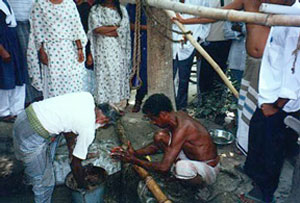 |
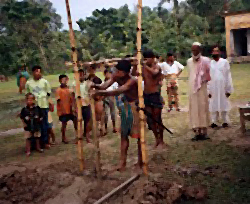 |
There are wells that are highly contaminated but a few wells show ground water arsenic concentration is far below Bangladesh standard. Based on an understanding of the geological origins of contamination, it may be possible to identify areas or strata that are at relatively low risk of arsenic contamination. In some areas arsenic contamination is confined to highly localized sedimentary deposits.
If these hot spots are identified through widespread arsenic testing, new wells can be preferentially installed in relatively safe areas. In areas where some geological units are arseniferous and others are not, it is important to avoid cross-contamination, which can occur in several ways. In some cases, the arsenic-rich zones may be naturally in hydraulic connection with arsenic-free zones.
By pumping water from arsenic-free zones, arsenic-rich water may be induced to flow into previously uncontaminated strata, and eventually may reach the well. In other cases, the arsenic-rich and arsenic-free zones may be separated by low-permeability materials such as clays. Drilling can disturb this natural barrier, and the borehole itself (specifically, the annular space around the well pipe) may
provide a high-permeability conduit from one zone to another.
When wells are drilled with mechanical rotary rigs, it is possible to inject impermeable material such as grouting or clay into this annular space at the level of the impermeable layer, to prevent this kind of contamination. However, in Bangladesh, grouting is not used, either to save money or because the drilling technologies are not compatible with grouting. In Faridpur almost all deep tube wells drilled under arsenic mitigation project are arsenic contaminated, possibly due to improper drilling.
It may sound puzzling but the aquifers are different. Local relief and rivers impact on the
direction and velocity of groundwater flow and therefore on the migration of arsenic. Groundwater flow from high to low relief causes deeper penetration contaminants into the aquifer. The reverse is true in areas that are low in relief. Here upward groundwater movement would bring contaminants to shallower
horizons. Shallower wells are clean because they contain mostly rainwater or water flowing swiftly through the sediments.
A sound knowledge
on underground geology, hydrology it is possible to identify arsenic free
aquifer at shallow depths. Ancienr river of Bangladesh is braided, anantomosed or meandering. Channel movement is dominated by lateral migration with some minor channel switching. The channels divide and rejoin around bars which scale with the banfull width and depth channel. Bar type include lateral (point) bars, diagonal bars, medial bars and trbutary bars. The sediment deposits show fining UPWARD SEQUENCE: This is a very cheap and highly acceptable
alternative.
We have identified a channel sand facies at Khalil Pur, Faridpur
At Khailpur most of the wells are arsenic contaminated but in some areas a few
wells found to be arsenic free. At Kahailpur after 12 drilling arsenic free
aquifer has been identified at depths 40-55 feet within channel sand facies.
At Alipur and Vashan Char, Ambikapur, Faridpur we have identified at 40-55 channel
sand facies with arsenic free aquifers.
We have identified a channel sand facies at Kazuri, Alipur (Ambikapur) in Faridpur.
At Kuzurdia, Bedbaria and Kasnail most of the wells are arsenic contaminated but a mid channel sand at a depth between 35 to 55 feet show arsenic free aquifer.
Back to Content
3. 4. 1. ARSENIC FREE VILLAGE AT KUZURDIA, FAIDPUR
Ana, 17 year girl studies at Oxford was thinking on her way back home from Oxford what should she do with the money that she saved during her stay. When she arrived at Dhaka airport, she told her mother, she wanted to donate this money for the poor. She knows that her uncle is engaged in some projects in Bangladesh that helps the poor to obtain arsenic free water.
She just wanted this money 280 English pound should be some help.
Like all villages in Bangladesh, Kazurdia a small beautiful village in Faridpur but one of the worst arsenic affected areas of Bangladesh. There is SEVERAL DEATHS AND ARSENIC PATIENTS IN THIS VILLAGE. During our stay for three months we observed three deaths due to drinking arsenic contaminated water (above 500 µg/l)
We have selected this village for obtaining arsenic free water on the basis of geological information.
We have found an arsenic free layer (aquifer) but not continuous. We have set 7 ARSENIC FREE WELLS. About 1000-2000 villagers are now drinking arsenic free water. This is a cheap method and with a sound knowledge on ground water hydrology can be applied to many worst arsenic affected areas of Bangladesh. It is not explainable why NGOs and different organisations depending on advise of expensive foreign consultants and experts spending taxpayer's money for deep tube wells and expensive unworkable filters. THANKS TO ANA. A great donation and a big impact!
This method can be applied to other areas for easy and cheap access of arsenic free
water. This needs careful formation evaluation and routine monitoring.
Hammer drilling equipment or vibro-core is required; unfortunately it is not
available in Bangladesh.
Kuzurdia--an arsenic-free village
Back to Content
4. CONCLUSION
Even after several years mitigation activities by the NGOs or Government are almost absent. Government's inaction putting huge number of people at risk. Our heart goes out to Sumon, a fourteen year old boy who lost one of his legs at such a tender age due to drinking arsenic poisoned water. Our reporter, who has recently visited a small village in Noakhali, says that Sumon is not alone, there are hundreds of others awaiting a similar fate. In fact, estimates show that Bangladeshis exposed to high levels of arsenic vary from a low of 2835 million to as high as 77 million, more than half the country's population.
The World Health Organisation describes the arsenic contamination of ground water as "the largest mass poisoning of a population in history." But we fail to understand why a comprehensive mitigation programme has not been achieved since almost all concerned have admitted that it is a serious threat to human lives (Editorial, The Daily Star, 22 June, 2003).
The development partners have pumped millions of dollars into various mitigation programmes ever since dangerous level of poison in underground water was detected way back in 1993. More funds are reported to be pouring in but the question is are they reaching the people who have been most affected by this rapidly increasing menace around the country? Several NGOs have been given authority through the Department of Public Health Engineering (DPHE), to offer low cost services to prevent diseases caused by arsenic poisoning from spreading. One such project for the 'poorest of the poor' requires a group of fifty to donate as much as Tk. 4,500 in advance to receive a safe tubewell.
But the government seems to have forgotten that there are many 'poorest of the poor who would not be able to gather any money, least of all the required amount (The Daily Star, June 22, 2003).
Present project with a very limited budget has a big impact. But thousands of villages remain untouched. We request differen orginisations to follow our poicy.
Dug wells and rainwater harvestings have shown that arsenic free water can be obtained at low cost. There are millions of population still does not have access to arsenic and disease free water.
It is strongly recommended to look for arsenic free aquifers. A sound knowledge on underground geology, hydrology it is possible to identify arsenic free aquifer at shallow depths. This is a very cheap and highly acceptable alternative.
The immediate alternatives are:
Deep tube wells in Southern Bangladesh but considering salt water intrusion.
"Arsenic free water trap" at shallow depths.
Dug wells.
Rain water harvesting.
Low cost community based water purification units.
New and immediate agricultural policy - "Flood Water Irrigation".
Dr. Jamal Anwar, project Co-ordinator:
Jamal@sos-arsenic.nett
PROJECT REPORT 2004
WOMEN PROJECT
EDUCATIONAL PROJECT
HELP
Top
Home
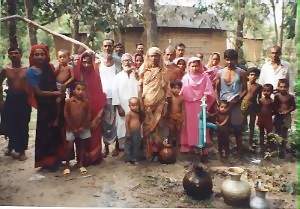
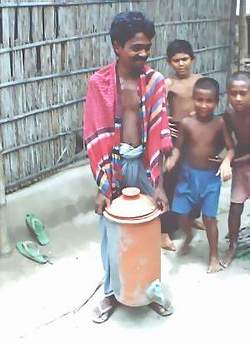
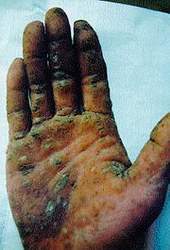
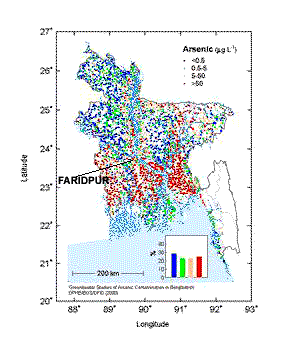 British Geological survey (1998) has compiled nation-wide distribution of arsenic in ground water at union level on computer and geocoded to thana (Police Station) level that indicates that southwest region is extensively contaminated. The most intensely contaminated areas are found along the Lower Meghna in the greater districts of Comilla, Noakhali, Kustia and Faridpur. But more arsenic contaminated areas are discovered after water test. Faridpur is one of the "hot spots" - worst arsenic affected areas of Bangladesh.
British Geological survey (1998) has compiled nation-wide distribution of arsenic in ground water at union level on computer and geocoded to thana (Police Station) level that indicates that southwest region is extensively contaminated. The most intensely contaminated areas are found along the Lower Meghna in the greater districts of Comilla, Noakhali, Kustia and Faridpur. But more arsenic contaminated areas are discovered after water test. Faridpur is one of the "hot spots" - worst arsenic affected areas of Bangladesh.